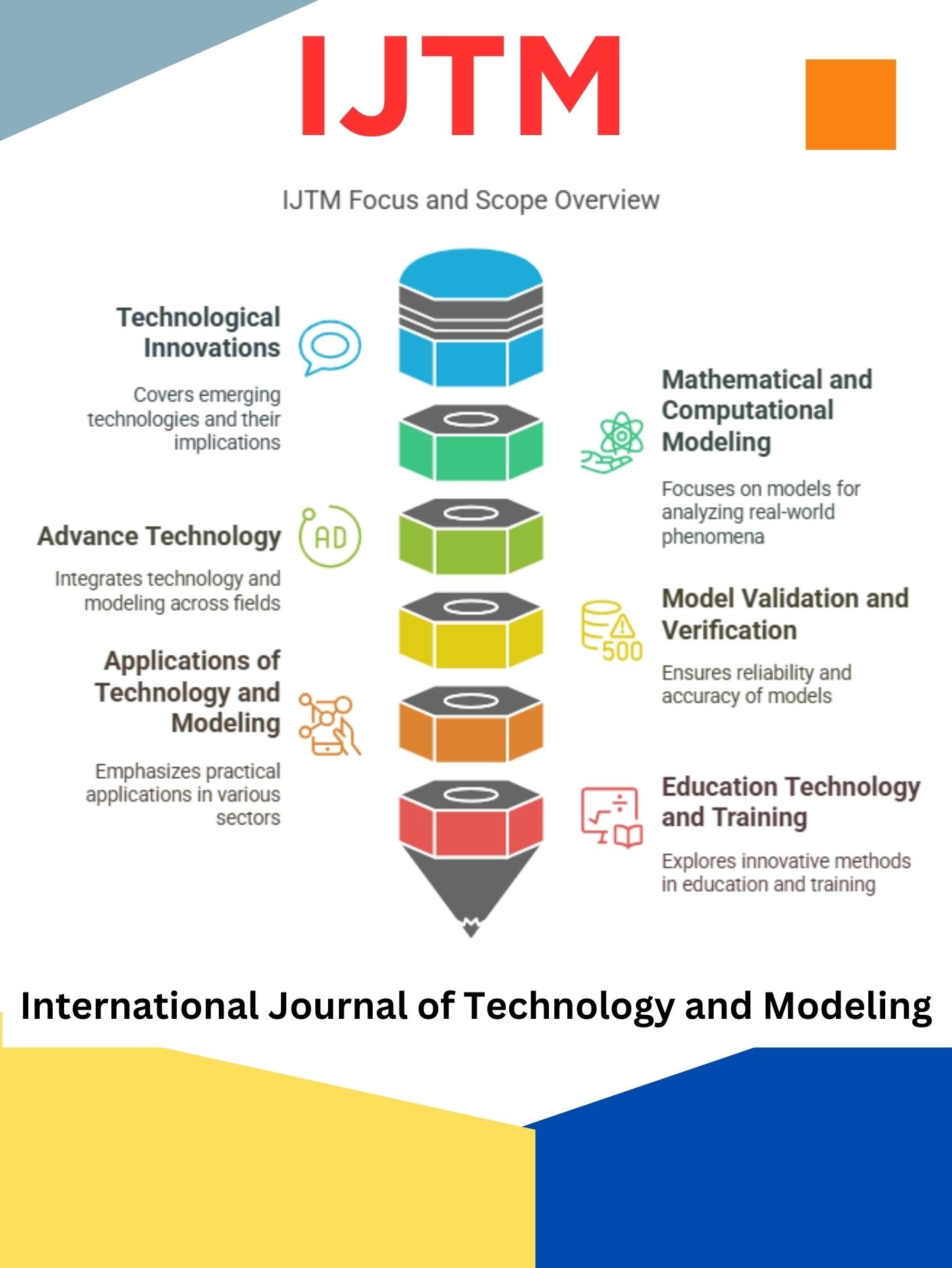Revolutionizing Industries: The Role of Technological Innovations in Modern Business Practices
DOI:
https://doi.org/10.63876/ijtm.v4i2.136Keywords:
Technological innovation, digital transformation, business practices, industrial development, Cameroon, emerging economiesAbstract
Technological innovation has emerged as a critical driver in transforming modern business practices across the globe. This study investigates the extent to which technological advancements have reshaped industrial operations and business strategies within the Cameroonian context. Using a mixed-methods approach, we collected data from 150 businesses across various sectors, complemented by in-depth interviews with industry leaders and technology stakeholders. The findings reveal a strong correlation between the adoption of emerging technologies—such as artificial intelligence, cloud computing, and automation—and improvements in productivity, operational efficiency, and market competitiveness. However, the study also highlights persistent challenges, including infrastructure deficits, limited digital literacy, and regulatory constraints that hinder full-scale adoption. Our analysis underscores the need for targeted policy reforms, capacity-building initiatives, and strategic investments to foster a more innovation-friendly ecosystem. This research contributes to the growing body of knowledge on digital transformation in emerging economies and offers actionable insights for business leaders, policymakers, and development practitioners aiming to harness technology for sustainable industrial growth.
Downloads
References
Z. Wang, L. Gao, and W. Wang, “The impact of supply chain digitization and logistics efficiency on the competitiveness of industrial enterprises,” Int. Rev. Econ. Financ., vol. 97, p. 103759, Jan. 2025, doi: https://doi.org/10.1016/j.iref.2024.103759.
A. Subagja, G. Watanto, and A. Mujadi, “Predictive Maintenance Strategies for Industry 4.0: A Modelling Approach,” Int. J. Technol. Model., vol. 3, no. 3, pp. 121–128, Dec. 2024, doi: https://doi.org/10.63876/ijtm.v3i3.121.
C. M. Gonzales, D. R. Salazar, S. N. Uy, and R. C. Lim, “Hybrid Deep Learning and Agent-Based Modeling for Dynamic Urban Traffic Forecasting in Smart Cities,” Int. J. Technol. Model., vol. 4, no. 1, pp. 48–62, Apr. 2025, doi: https://doi.org/10.63876/ijtm.v4i1.129.
Z. Tang, S. Tang, and J. Zou, “Artificial intelligence and global embodied carbon flow: Evidence from the application of industrial robots,” Habitat Int., vol. 165, p. 103560, Nov. 2025, doi: https://doi.org/10.1016/j.habitatint.2025.103560.
A. Kessler, H. Frank, and E. Fuetsch, “Conceptualizing digitalization orientation as a strategic posture – How to boost the impact of digital technologies in businesses: A qualitative good practices approach,” Technol. Forecast. Soc. Change, vol. 213, p. 123997, Apr. 2025, doi: https://doi.org/10.1016/j.techfore.2025.123997.
A. Haruna, H. T. Oumbé, A. M. Kountchou, and C. B. Pilag Kakeu, “Can Islamic finance enhance the innovation capacity of Cameroonian SMEs? Empirical evidence based on a multivariate probit approach,” Borsa Istanbul Rev., vol. 24, no. 1, pp. 187–200, Jan. 2024, doi: https://doi.org/10.1016/j.bir.2023.11.006.
M. Kadji Ngassam, “Trust and involvement of Cameroonian software developers in open-source projects,” Data Sci. Manag., vol. 7, no. 4, pp. 332–339, Dec. 2024, doi: https://doi.org/10.1016/j.dsm.2024.04.005.
E. A. Ekani Bidzanga and S. M. Eke Balla, “Impact of environmental practices on productive efficiency of industrial firms in Cameroon,” World Dev. Perspect., vol. 38, p. 100680, Jun. 2025, doi: https://doi.org/10.1016/j.wdp.2025.100680.
Z. Liu, W. Cheng, M. He, C. Duan, and X. Pan, “Digital technology innovation, value chain reshaping and digital transformation,” Financ. Res. Lett., vol. 85, p. 107850, Nov. 2025, doi: https://doi.org/10.1016/j.frl.2025.107850.
T. Provensi, S. Sehnem, and C. J. Chiappetta Jabbour, “Circular economy and disruption in the value chain: The role of stakeholders and networks in startups,” J. Environ. Manage., vol. 371, p. 123117, Dec. 2024, doi: https://doi.org/10.1016/j.jenvman.2024.123117.
I. Jebbor, Z. Benmamoun, and H. Hachimi, “Forecasting supply chain disruptions in the textile industry using machine learning: A case study,” Ain Shams Eng. J., vol. 15, no. 12, p. 103116, Dec. 2024, doi: https://doi.org/10.1016/j.asej.2024.103116.
Q.-J. Wang, Y.-J. Zhu, Y. Zhang, and C.-P. Chang, “Impact of digital economy on energy efficiency: Role of emerging technologies such as AI,” Energy Econ., vol. 150, p. 108840, Oct. 2025, doi: https://doi.org/10.1016/j.eneco.2025.108840.
G. Myovella, M. Karacuka, and J. Haucap, “Determinants of digitalization and digital divide in Sub-Saharan African economies: A spatial Durbin analysis,” Telecomm. Policy, vol. 45, no. 10, p. 102224, Nov. 2021, doi: https://doi.org/10.1016/j.telpol.2021.102224.
M. Kasusse, “Bridging the digital divide in Sub-Saharan Africa: The rural challenge in Uganda,” Int. Inf. Libr. Rev., vol. 37, no. 3, pp. 147–158, Sep. 2005, doi: https://doi.org/10.1016/j.iilr.2005.07.001.
E. K. Manu, D. Atitie, and S. A. Asongu, “One size does not fit all: sustainable innovation, economic policy uncertainty and competitive market dynamics on the circular economy of Sub-Saharan Africa,” J. Environ. Manage., vol. 392, p. 126804, Sep. 2025, doi: https://doi.org/10.1016/j.jenvman.2025.126804.
I. L. Ridwan, A. R. B. S. Senathirajah, and M. A. S. Al-Faryan, “Investigating the asymmetric effects of financial development on trade performance in Africa: Can digitalization, transport services, and regulatory quality drive the vision 2063?,” J. Econ. Asymmetries, vol. 30, p. e00390, Nov. 2024, doi: https://doi.org/10.1016/j.jeca.2024.e00390.
A. M. Ojuolape, S. Mohd, and O. O. Benjamin, “Dataset of youth and middle-aged unemployment in households in Kwara State, Nigeria,” Data Br., vol. 55, p. 110638, Aug. 2024, doi: https://doi.org/10.1016/j.dib.2024.110638.
G. S. Ketchoua, M. A. K. Wirajing, and I. Ketu, “Advancing agro-environmental sustainability in Africa: The critical role of infrastructure development and banking sector stability,” Sustain. Futur., vol. 9, p. 100800, Jun. 2025, doi: https://doi.org/10.1016/j.sftr.2025.100800.
S. Prakongwittaya and J. Liangrokapart, “Integrating LARG measures to improve supply chain transparency performance,” Asia Pacific Manag. Rev., vol. 30, no. 1, p. 100324, Mar. 2025, doi: https://doi.org/10.1016/j.apmrv.2024.09.002.
Y. Xiong and X. Li, “The dynamic mechanism of tentative governance for emerging technologies: A case study of China’s new energy vehicle subsidy,” J. Clean. Prod., vol. 484, p. 144328, Dec. 2024, doi: https://doi.org/10.1016/j.jclepro.2024.144328.



